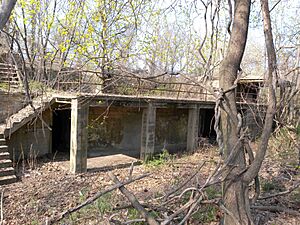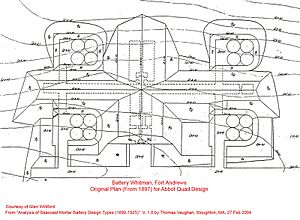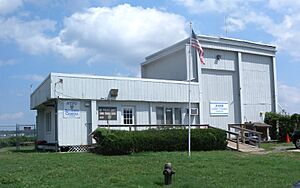Fort Totten (Queens) facts for kids
Quick facts for kids Fort Totten |
|
|---|---|
| Part of Coast Defenses of Eastern New York | |
| New York City borough of Queens, New York | |
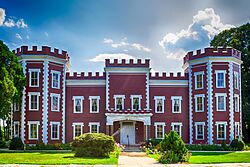
The former Fort Totten Officer's Club
|
|
| Coordinates | 40°47′31.3″N 73°46′33.9″W / 40.792028°N 73.776083°W |
| Site information | |
| Owner | New York City Department of Parks and Recreation (primarily) |
| Open to the public |
Civil War fort, some other activities |
| Site history | |
| Built | 1862 |
| Built by | United States Army Corps of Engineers |
| In use |
|
| Materials | granite |
| Fate | Active use by U.S. Army Reserve. Portions converted for use as public park. Other portions converted for use by the NYPD and FDNY. |
Fort Totten is a historic former United States Army base located in Queens, a borough of New York City. It sits on the north shore of Long Island, right where the East River meets Long Island Sound at the top of Little Neck Bay.
While a part of the U.S. Army Reserve still uses the fort, most of the land is now owned by the City of New York. It serves as a public park and a training center for city services.
History of Fort Totten
Building the Fort: Civil War Era
Construction on what was then called the Fort at Willets Point began in 1862. The U.S. Government had bought the land from the Willets family in 1857. The fort was officially named Fort Totten in 1898.
Its main job was to protect the East River entrance to New York Harbor. It worked together with Fort Schuyler, which was across the river in the Bronx. This fort was one of many new coastal defenses built during the American Civil War.
The first plans for the fort were drawn up by Robert E. Lee in 1857. Later, Joseph G. Totten, a Chief Engineer, made changes to the design. The fort was unique because it was planned to have four levels of cannons facing the water. However, construction stopped after the Civil War. This was because new weapons showed that old masonry (stone) forts could be easily damaged. Only one and a half levels of the water-facing walls were finished. The land-facing walls were barely started. From 1861 to 1898, the area was known as Camp Morgan.
Engineer School and Underwater Mines (1869–1890)
In 1869, the Engineer School of Application moved to the future Fort Totten. It stayed there until 1901. One of its first important tasks was to develop underwater minefields. These minefields would be a key part of coastal defense for many years. Major Henry Larcom Abbot, who led the school, was very important in creating these.
During the 1870s, two large earthwork batteries were built. One had 27 cannons, and the other had 16 mortars. The mortar battery was a test version of the "Abbot Quad" design. This design was later used for the first 12-inch coast defense mortars in the 1890s. In 1890, the Engineer School even experimented with the Sims torpedo, an electric torpedo partly designed by Thomas Edison.
Upgrading Defenses: The Endicott Era (1890–1916)
In 1885, the Endicott Board suggested many new coastal defenses. Fort Totten was one of the forts chosen for upgrades. In 1898, the fort was named after Major General Joseph Gilbert Totten. He was a famous American fort designer from the early 1800s.
New gun batteries were built between 1897 and 1904. These were part of the Coast Defenses of Eastern New York. They included powerful 12-inch mortars, 12-inch guns, 10-inch guns, and 8-inch guns. There were also smaller 5-inch and 3-inch guns.
A special building for controlling underwater mines was also built around 1900. In 1901, the Engineer School moved away. The new United States Army Coast Artillery Corps then took over developing coastal defenses. Most of Fort Totten's large guns were removed by 1935.
Fort Totten During World War I
When the United States entered World War I, many coastal forts changed. They became important places for training soldiers. Many of their large guns were removed. The idea was to send these guns to the Western Front in Europe.
The Coast Artillery Corps used almost all of the heavy and railway artillery for the war. Fort Totten's 5-inch, 8-inch, 10-inch, and 12-inch guns were taken down between 1917 and 1918. They were planned to be used as railway guns or field artillery. However, many of these guns did not reach France or were not ready for battle before the war ended in November 1918.
Between the World Wars
In 1920, some of Fort Totten's 3-inch guns were removed. Around this time, a battery of three anti-aircraft guns was built. In 1935, the last heavy weapons at Fort Totten, the mortars, were removed. This meant the Harbor Defenses of Eastern New York were mostly inactive. Only four 3-inch guns remained at Fort Totten through World War II, likely to guard a possible minefield.
Fort Totten in World War II
In December 1941, Fort Totten became the main office for anti-aircraft defenses along the entire east coast. This was part of the Eastern Defense Command. On May 9, 1942, the Harbor Defenses of Eastern New York joined with the Harbor Defenses of New York. The Eastern New York command officially ended on May 22, 1944.
The Cold War Era
In 1954, Fort Totten became a Project Nike air defense site. While no Nike missiles were actually kept at Fort Totten, it served as the main headquarters for the New York area's air defense. Administrative offices and housing for personnel were located there. By 1966, it was the headquarters for the 1st Region of the Army Air Defense Command.
Fort Totten was also home to the headquarters for the 66th Anti-Aircraft Missile Battalion and the 41st AAA Gun Battalion. The 66th Battalion's missiles were on nearby Hart Island. The 41st Battalion's 90 mm guns were placed across Long Island.
Changes in the 1970s
In 1974, after the Vietnam War, the U.S. military reduced its budget. The Nike missile system was also shut down in the United States. Because of these changes, Fort Totten was closed as a regular Army base. The U.S. Army Reserve then took over the remaining military presence.
Fort Totten Today
Today, the military presence at Fort Totten includes the 77th Sustainment Brigade and its units from the U.S. Army Reserve.
Most of Fort Totten is now a public park. The New York City Department of Parks & Recreation offers tours. You can reach the fort by the Cross Island Parkway and Clearview Expressway. The Fort Totten Visitor's Center has been updated and has a museum about the fort's history.
Parts of the fort are used by the New York Police Department (NYPD) and the New York Fire Department (FDNY) as a training center. The US Coast Guard Auxiliary, Flotilla 12-1, is also located here.
During winter, many different kinds of migratory waterfowl can be seen in the surrounding waters. These include Little Bay, Long Island Sound, and Little Neck Bay. While some buildings are old and unused, Fort Totten also has a sports complex. It features an outdoor pool, baseball fields, and soccer fields for youth sports.
Fort Totten is recognized as a New York City Historic District.
The Fort Totten Officers' Club
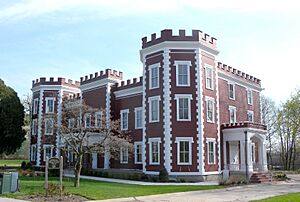
The Fort Totten Officers' Club, often called "the Castle," is a special building at the fort. It is now home to the Bayside Historical Society. This society hosts events, history exhibits, and cultural programs. The club was added to the National Register of Historic Places in 1986.
The building was designed in the neo-Gothic style, which was popular at the time. It was not made just for Fort Totten. It was a standard design approved by the Army for use at military bases. Similar buildings were constructed at other Army forts. The U.S. Army Corps of Engineers even adopted a castle design as their symbol. This symbol has been linked to Army engineers since around 1840.
See also
- Fort Totten (disambiguation)
- Seacoast defense in the United States
- Totten (disambiguation)
- United States Army Coast Artillery Corps





